Westland Lysander, T1552, 25th July 1942
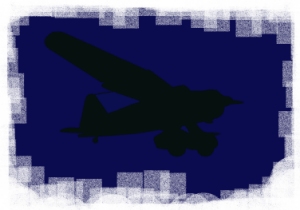 On July 25th
1942, the Irish Army stationed in the Inishowen Peninsula in
Donegal had to respond to a report of an aircraft having landed
on the beach near Ballyliffen.
On July 25th
1942, the Irish Army stationed in the Inishowen Peninsula in
Donegal had to respond to a report of an aircraft having landed
on the beach near Ballyliffen.
It turned out that at 18:30 hours that evening, a single engine Royal Air Force (RAF) Westland Lysander aircraft had made an emergency landing. The crew of two men reported they were flying from Valley in Angelsey, Wales, saying they had lost their bearings and had been forced to land having only a half hours fuel left.
The subsequent Irish Army Intelligence (G2) report, G2/X/1038, went on to record the names of the crew as Flight Lieutenant "J. Crabbe" and Sergeant "A. Fryer". No christian names or service numbers were recorded in the report or at least don't seem to have survived if they were. The Lysander, a type operated by the Irish Air Corps at this time also, was recorded as such but no external identifying marks such as a serial number were noted. What was however recorded were the next of kin addresses of the two men, Yeadon, Leeds for Crabbe and Coventry for Fryer.
The two airmen were accommodated over night in Fort Lenan with the Irish Army Garrison there. Additional fuel was delivered from Northern Ireland the next day and, refueled, the Lysander and it's crew took off at 13:30 hours. The report records the crew as being 'on a training flight' thus giving the authorities the necessary free hand to allow the crew to depart and not be interned. At this stage in the war, Allied crew were not regularly being interned in any case. This done, the file was prepared and entered in the records.
In 1987, Flypast magazine published a two part article by Dave
Smith on the aircraft which crashed or landed in Ireland during
the war. It included an extract from the Operations Record Book
(ORB) of 275 Squadron based at RAF Valley at that time, relating
that one of their aircraft flown by Flt/Lt Crabb, the Officer
Commanding 1486 Gunnery Training Flight, had avoided internment
after landing on a beach in Eire by claiming that he and his
aircraft were involved in a 'humanitarian flight'. The available
pages of 275 Squadron ORB however don't appear to contain this
narrative. It relates that some of their Lysander and
Walrus aircraft were launched to search for an aircraft reported
overdue at Andreas in the Isle of Man. When the last
aircraft returned to base it was learned that the missing
aircraft had landed in Eire. 1486 Flight was at that time
referred to as 1486 (Fighter) Gunnery Flight.
The Irish Army G2 file was reviewed 2006 at the Irish Military Archives in Cahal Brugha Barracks, Rathmines. Noting the relevant information and in particular the two men's next of kin addresses the the local newspapers and libraries in Yeadon and Coventry were contacted.
Sgt. John 'Jack' William Frederick Fryer 1198788 RAFVR
First success came with Coventr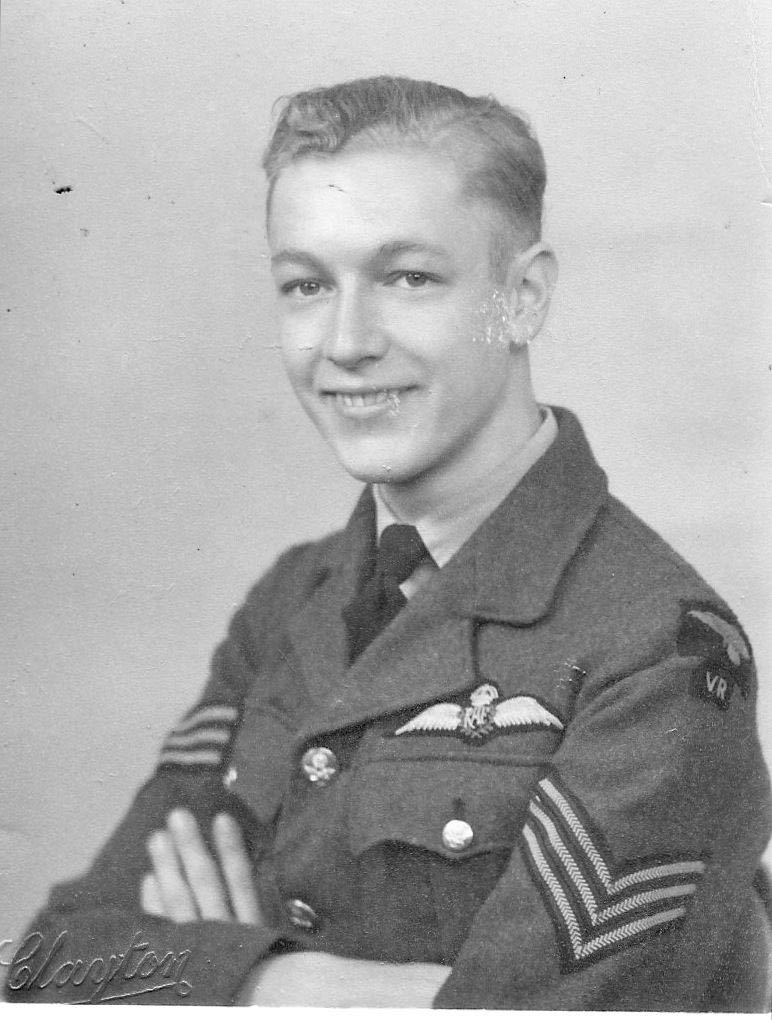 y Library who were able to advise
that a John W F Fryer was registered at that address with his
family after the war up until the early fifties. A search of the
London Gazette newspaper did confirm that there was one John
William Frederick Fryer who served with the RAF during the war.
Replies were then received from a letter printed in the Coventry
Telegraph from two Coventry men who wrote that they knew a Jack
or Jackie Fryer who lived at the address in the Irish Army
report, had served with the RAF and who ran with the Godiva
Harriers Athletic Club. He used to be a visitor to the home of
John Hartley, on club business with Mr. Hartley's father, a club
official. John Hartley remembers him as being light hearted and
humorous. Ron Bettridge, the other writer, used to visit the
Fryer household with his mother before the war. He recalls that
the man he knew as Jackie Fryer was at that time learning to
play the saxophone and clarinet. Ron, a teenager at the time,
learned through his mother that Jackie went on to fly fighters
with the RAF and served in North Africa. He also noted that
Jack's sister's name was Joyce, one of the name's on the
Coventry Library records. Ron used to follow Jackie's running
results in the same Coventry Telegraph newspaper after the war.
John Hartley did pass on the sad news that Jack Fryer had passed
away. Jack had married postwar, had two children and passed away
in Scunthorpe in 1983.
y Library who were able to advise
that a John W F Fryer was registered at that address with his
family after the war up until the early fifties. A search of the
London Gazette newspaper did confirm that there was one John
William Frederick Fryer who served with the RAF during the war.
Replies were then received from a letter printed in the Coventry
Telegraph from two Coventry men who wrote that they knew a Jack
or Jackie Fryer who lived at the address in the Irish Army
report, had served with the RAF and who ran with the Godiva
Harriers Athletic Club. He used to be a visitor to the home of
John Hartley, on club business with Mr. Hartley's father, a club
official. John Hartley remembers him as being light hearted and
humorous. Ron Bettridge, the other writer, used to visit the
Fryer household with his mother before the war. He recalls that
the man he knew as Jackie Fryer was at that time learning to
play the saxophone and clarinet. Ron, a teenager at the time,
learned through his mother that Jackie went on to fly fighters
with the RAF and served in North Africa. He also noted that
Jack's sister's name was Joyce, one of the name's on the
Coventry Library records. Ron used to follow Jackie's running
results in the same Coventry Telegraph newspaper after the war.
John Hartley did pass on the sad news that Jack Fryer had passed
away. Jack had married postwar, had two children and passed away
in Scunthorpe in 1983.
In January 2007, one of the always kind posters on the RAF Commands message forum, mentioned he could provide an index of aircrew log books held by the DORiS archive at the RAF Museum at Hendon, north of London. One of the listed logs was that of a John William Frederick Fryer! A request to the museum yielded the reply that this was indeed the log book of the Sgt. Fryer I sought! He recorded in his log that he was being transferred from Valley by Flt/Lt Crabb to 93 Squadron at Andreas on the Isle of Man. Their compass failed and they had to force land at Ballyliffen in Eire. The next two entries have them flying to Eglinton airfield in Northern Ireland and thence to Andreas their original destination. 93 Squadron had indeed prepared at Andreas and in the Winter of 1942 moved to Gibraltar and thereafter fought in the campaign in Tunisia.

Above, the extract from Jack Fryers log book showing the
landing in Donegal.
Finally in 2016, contact was made with Jack Fryers daughter and
she was able to provide a number of wonderful photos on of Jack
while on duty. Her husband was able to provide the
following narrative on Jacks service,
"Whilst at a Christmas works party in
about 1978, I was with Squadron Leader J.W.F. Fryer, my
father in law to be. We were talking to an Irishman who
worked for the BBC and was called MacKenzie too. I commented
on his name and that his accent was not Scottish. He replied
that he came from a little village in Eire called
Ballyliffie (I may have the wrong spelling).
John Fryer said “I think I know the place” and went on
to describe the police station in some detail. Mr MacKenzie
confirmed the description and asked how he came to know it
so well, “you weren’t locked up there were you?” Now at this
point I should point out that John was never one to spoil a
good story for a halfpence worth of truth, but it does all
ring true. He said that they were delivering an aeroplane to
Northern Ireland, when an instrument fault forced them to
land in the Republic. They were immediately arrested by the
Garda and taken to the police station. However, they were
put in an unlocked cell and were able to make good their
escape.
John went on to serve in Egypt, Sicily, Italy and
Germany. I should perhaps add a caveat. I noted a
discrepancy between his medals proper and the miniature on
his mess kit. He explained that you have to apply for those
on the mess kit and he had not applied for the Sicily star,
as he left Egypt flat on his back with amoebic dysentery
(amoebiasis), spent 6 months in a Sicilian hospital
and then moved to Italy, before recovering. He
therefore thought it ingenuous to claim a medal for that
kind of service. In training he was known as Jackie, in
Italy he was known as Willy, but since then, just plain
John.
After his wartime service he had a short spell in
civilian life before returning to the RAF with a commission.
He served in Germany, Bruni, Singapore and of course all
over Lincolnshire. Most of his latter service was in Air
Traffic Control, he worked on the Berlin airlift and
latterly was SATCO (Station Air Traffic Control) at RAF
Manby and GATCO (Group Air Traffic Control) for the east
midlands based at Finningly (now the Doncaster Robin Hood
Airport). He retired from the Air Force as a Squadron Leader
and worked for several years until his death in 1983 (aged
63) as the Secretary of the Community Health Council, based
in Scunthorpe.
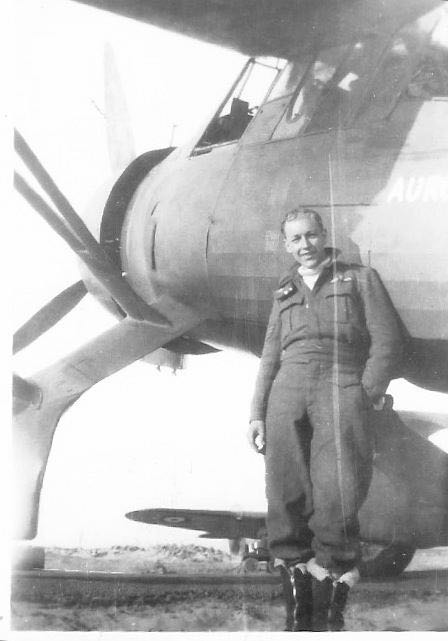 I have attached some photos of
John with Lysanders, This was rare as, once he finished
training, he flew almost exclusively Spitfires. I also
include a photo of him as a sergeant pilot and outside
Buckingham Palace as a Sqdn. Ldr., on his way to the garden
party. There is also a photo of him at Hendon Museum in
front of a Hurricane he once flew. It was a training
aircraft, so most of his colleagues would have flown it too.
I have attached some photos of
John with Lysanders, This was rare as, once he finished
training, he flew almost exclusively Spitfires. I also
include a photo of him as a sergeant pilot and outside
Buckingham Palace as a Sqdn. Ldr., on his way to the garden
party. There is also a photo of him at Hendon Museum in
front of a Hurricane he once flew. It was a training
aircraft, so most of his colleagues would have flown it too.
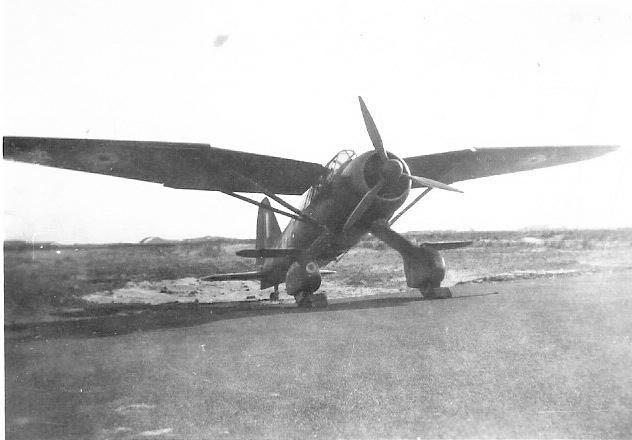
I don’t know if it will be
of interest to you, but he had another very close call in
Italy on 4 January 1945. I have attached a photo of him in
front of his Spitfire IX with a large hole in it. His log
for that day reads “What a show. We got 6 direct hits and
left the whole place burning (Jerry H.Q. south of Lugo). I
got hit by a 20mm in the oil tank (of the Merlin engine).
Just got back as she started to burn. No oil or glycol the
engine. Target observed burning 8 hours later.” The shell
lodged in the sump of the engine. Despite losing oil and
power, he managed to nurse his aeroplane back to base. He
calculated a difference in trajectory of 1.5 degrees would
have shot his arse off - hence the silly grin (his words not
mine).
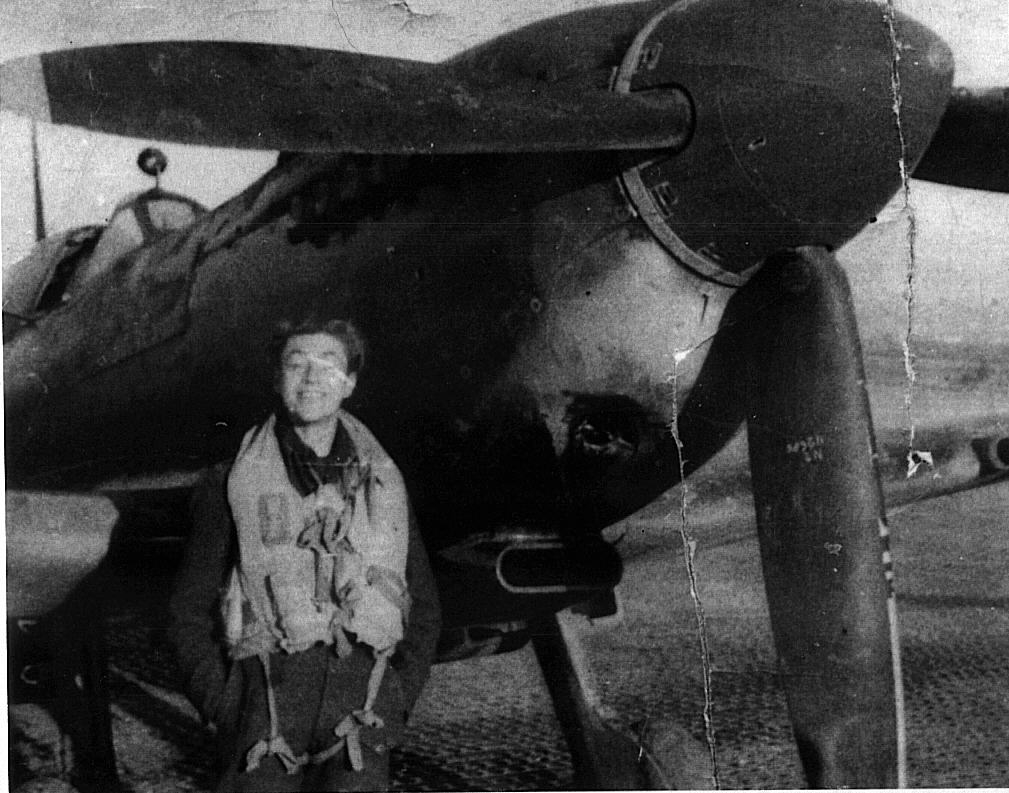
The squadron ORB records the aircraft as being Spitfire HF.IX
PT764, coded HN-S. It was repaired by the 11th January
when he flew it on an air test and then took it on a combat
mission on the 17th January.
Flt/Lt John Malcolm Crabb 84967 RAFVR KIA 7 Jan 1944
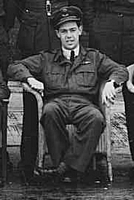 The
letter sent to the newspaper in Yeadon resulted in the receipt
of a letter from a woman in South West England in October 2006.
This letter was from non other than the widow of Flt/Lt J Crabb!
A good friend of hers, still living in Yorkshire, had seen my
letter in the Wharfedale Observer newspaper and had the good
fortune to send it on to her. The address in Yeadon had been her
parent's where she was living at the time while her then
husband, John Malcolm Crabb, from Leicester, was on active
service. She was able to confirm that he was in 1942 stationed
at RAF Valley, in Wales acting in a training roll. They had met
in London while both were working for the Civil Service before
the war. They were married in April 1942 in Yeadon but sadly,
the maelstrom of war would take John from her after only 21
months.
The
letter sent to the newspaper in Yeadon resulted in the receipt
of a letter from a woman in South West England in October 2006.
This letter was from non other than the widow of Flt/Lt J Crabb!
A good friend of hers, still living in Yorkshire, had seen my
letter in the Wharfedale Observer newspaper and had the good
fortune to send it on to her. The address in Yeadon had been her
parent's where she was living at the time while her then
husband, John Malcolm Crabb, from Leicester, was on active
service. She was able to confirm that he was in 1942 stationed
at RAF Valley, in Wales acting in a training roll. They had met
in London while both were working for the Civil Service before
the war. They were married in April 1942 in Yeadon but sadly,
the maelstrom of war would take John from her after only 21
months.
Based on searches of Squadron records, a F/O J M Crabb was
posted into No. 3 Squadron at the start of October 1940 from 5
Operational Training Unit. That unit was then equipped
with Hurricane fighters. He began flying missions in
November. He was part of a two plane flight that attacked
a Focke Wulf Condor on the 2 March 1941. By July 1941, he
was flying Hurricanes on single plane night intruder missions
into France. His experience led to his posting into No 1
Squadron in early 1941 as B Flight commander. This unit
was at that time performing night fighter duties. On 13
April 1942 the ORB records: F/Lt
J.M.Crabb (84967) proceeded to R.A.F. Station Warmwell for
course, on posting to 1486 Flight at Valley w.e.f. 9.4.42.
He is found next posted
in January 1943 to 193 Squadron, as commander, B Flight, a
fighter bomber unit awaiting arrival of their new Hawker Typhoon
aircraft.
John was killed in action on January 7th, 1944 while flying
Hawker Typhoon JR436 with 193 Squadron, a fighter bomber unit
based at RAF Harrowbeer, near Plymouth. He was shot down over
the Channel and for that reason his remains were not recovered
and his name is thus recorded on Panel 202 of the Commonwealth
War Graves Commission Runnymede Memorial in Surrey. Ed McKay,
one of his comrades at the time was able to tell Stephen Fryer
of the RAF Harrowbeer Interest Group the following of John
Crabb, "Johnny Crabb was my Flight
Commander on 193 Squadron and was shot down by a 190 off the
Channel Islands. He was a top notch pilot and leader".
John's widow,
Margaret, married again after the war and lived then happily
with her husband in the South West of England. John was born
in Leicester in 1920, the son of Mary Isabella and William
Johnston Crabb. His father was a school master. Sadly, his
mother, Mary, passed away in the summer of 1935. He
had two brothers Donald and Colin. Colin
Martin Crabb himself also joined the RAF, was commissioned as an
Officer in late 1944. He stayed on in the RAF post war
reaching the rank of Squadron Leader.
The final piece of the jigsaw, the aircraft identity? The aircraft in Fryer's logbook, '1552', being a Lysander, can only match the serial number of aircraft T1552, a Lysander Mk. III, part of a batch of 250 delivered between Aug 1940 and Feb 1941. It had served with 4 Squadron but had been passed on to 9 Group Target Towing Flight which in turn became 1486 (Fighter) Gunnery Flight in early 1942. T1552 is listed as being assigned to this Flight, the same that was mentioned in the Flypast article. Thereafter, T1552 was passed onto the USAAF airbase at Goxhill, as a unit liaison aircraft presumably until it was struck off charge on 26 February 1944.
John Crabb had been commissioned as a Pilot Officer (P/O) on 7 Sep, 1940, promoted Flying Officer (F/O) 7 Sep, 1941 and Flight Lieutenant (Flt/Lt) on 7 Sep 1942.
John 'Jack' Fryer was commissioned as a P/O (service number 176380) on 22 Jan. 1944, prom. F/O 22 Jul. 1944 and Flt/Lt 22 Jan. 1946.
And so, the small mystery of the Ballyliffen Lysander is solved and the crew of Ireland's only wartime visiting Lizzie can be remembered.
Compiled 2023: With special thanks to M. Mill's, P & B MacKenzie, Victor Laing and the Irish Military archives staff, N. Burls at the RAF Museum, Hendon, R. Byatt at the Local Studies Service, Coventry Library, Ed McKay RAF (Ret), Stephen Fryer RAF Harrowbeer Airfield Group (www.rafharrowbeer.co.uk), The Wharfedale and Coventry Telegraph newspapers and their fabulous readers, R. Buttridge and J. Hartley of Coventry, D. Earl for information on T1552 from ?RAF Aircraft T1000 - T9999 J.J.Halley?, T. Kearns, E. Martyn for their assistance on the RAF Commands forum and M. Gleeson for encouragement, the London Gazette website.
